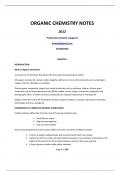ORGANIC CHEMISTRY NOTES
2012
Prepared by Driwale zulugama
driwale@gmail.com
0754302329
CHAPTER 1
INTRODUCTION
What is Organic chemistry?
Is the branch of chemistry that deals with the study of compounds of carbon
All organic compounds contain carbon together with one or more other elements such as hydrogen,
oxygen, chlorine, Nitrogen and sulphur
These organic compounds range from simple molecules such as methane, ethene, ethyne, giant
molecules such as Deoxyribonucleic acid (DNA),rubber, cotton, drugs, insecticides, explosives and
photographic films- of which all these compounds are of great importance in everyday life
Organic chemistry is also the foundation for basic studies in Botany, nutrition, agriculture, pharmacy,
technology, forestry, zoology etc
UNIQUENESS OF CARBON IN ORGANIC COMPOUNDS
Carbon behaves differently from the rest of the group members due:
Small Atomic radius
High electronegativity
Lack of vacant orbital
Some of the properties in which Carbon differs from the rest of the members include:
It forms a stable multiple bonds with itself and with other non-metals.
Carbon can form a number of hydrocarbons because it can catenate. Catenation is the
ability of the element to form bonds between atoms of the same element.
It forms gaseous oxides unlike other members
Page 1 of 109
, The halides are stable to hydrolysis.
CHARACTERISTIC PROPERTIES OF ORGANIC COMPOUNDS
Most organic compounds are:
Covalently bonded and generally gases, volatile liquids and low melting point solids
with few elements such as carbon, hydrogen, sulphur, nitrogen and halogens
Low melting and boiling point compounds
Generally insoluble in water except those with polar functional groups such as
OH, COOH, SO3H
The reactions are generally slow although some are explosive and most reactions
require catalysts
REACTANTS AND REACTIONS
In chemical reactions, the reactants molecules are that are attacked are called SUBSTRATE but the
general term given to the attacking substrate is called a REAGENT.
Substrates and Reagents usually interact to yield the products involve redistribution of electrons.
Generally there are two ways in which a covalent bond can be broken include:
(a) Homolytic cleavage
In this type, the bond is broken symmetrically and each atom remains with one electron to form
a radical
Example include
B A A + B
These types of reactions are usually catalysed by:
Ultraviolet light or short wavelength light or sunlight
High temperatures
Peroxide
(b) Heterolytic cleavage
In this of the reactions, the bonds are broken unsymmetrically generating cation and anion
If the molecule contains different atoms with different electronegativity, the tendency of ions
formation differs.
These breakages usually take place in solvents of high ionizing power which is catalysed by ionic
polar catalysts
Example include
If A is more electronegative than B, then
B A A- + B+
CARBOCATION OR CARBONIUM IONS
Page 2 of 109
,These are formed when fragments of a molecule in which a group and the bonding electrons are
removed from the carbon chain
Carbocations are divided into 10, 20 and 30
The stability of the Carbocations depend on the number of the electron releasing group e.g. CH3 and is
expressed as 30> 20> 10
ELECTROPHILES AND NUCLEOPHILES
Electrophiles are species which are electron loving since they are electron deficient while Nucleophiles
are species which are electron rich
Examples of Electrophiles and Nucleophiles include:
+
NO2 , H+, Cl+, Br+,R3C+ and RN2+
Electrophiles:
Nucleophiles: H2O, ROH,RO- ,-OH, Br- CN- and NH3
HYDROCARBONS
These compounds that contain carbon and hydrogen as the only elements present.
They are classified as:
(a) Saturated hydrocarbons
These are hydrocarbons that contain a carbon- carbon single bond e.g. in Alkanes
(b) Unsaturated hydrocarbons
These are hydrocarbons that contain multiple bonds between the carbon atoms e.g
Alkenes
Further classification includes:
(a) Aliphatic Hydrocarbons
These are hydrocarbons that contain low carbon-hydrogen ratio. Usually on burning,
they burn with a non-sooty flame.
(b) Aromatic hydrocarbons
These are hydrocarbons that contain a high carbon- hydrogen ratio. Usually on burning,
they burn with a sooty flame. These compounds are usually considered as derivatives of
benzene.
N.B Also Alicyclic hydrocarbons which are hydrocarbons in which carbon atoms are arranged in the ring
other than benzene ring e.g
Page 3 of 109
, FUNCTIONAL GROUPS AND HOMOLOGOUS SERIES
Homologous series is a series in which organic compounds can be placed. The characteristics of
homologous series include;
Member of a homologous series can be represented by a general formula e.g. CnH2n+2 for Alkanes,
CnH2n for Alkenes
Each member of a series has a similar method of preparation
Members in a given series has a similar chemical properties to each other
As a series is ascended down, a methylene group is added to each successive member therefore
physical properties such as boiling and melting points change slightly.
Several homologous series are regarded as alkane derivatives since the hydrogen atom in the alkane
is replaced by a functional group
Functional group is atom or group of atoms which impart specific chemical properties to the chemical
compounds containing then regardless of the nature of the hydrocarbon part of the molecule.
Generally Organic compounds are classified based upon the functional group because compounds
having the samefunctional groups have the similar chemical properties.
The table below shows some of the examples of functional groups:
Name Structural formula Examples
Alkane RH or CnH2n+2 CH3CH2CH3
Alkenes RCH=CH2 or CnH2n CH3CH=CH2
Alkynes RC CR
or Cn H2n-2 CH3C CCH3
Halogen compounds RCH2X (x=Cl, Br and I) CH3CH2Cl
Alcohols RCH2OH or CnH2n+1OH CH3CH2OH
Carbonyl compounds Aldehydes: RCHO or CH3CH2CHO
CnH2n+1CHO
Ketones: RCOR or CnH2n+2CO CH3COCH3
Carboxylic acids RCH2COOH or CnH2n+1COOH CH3COOH
Amines RCH2NH2or CnH2n+1COOH CH3CH2NH2,CH3NHCH3
Ethers ROR or CnH2n+1O CH3CH2OCH3
TYPES OF ORGANIC REACTIONS
Organic reactions are usually initiated by Electrophiles or Nucleophiles or free radical attack upon the
substrate. These reactions include:
(a) Substitution or Displacement reactions
Page 4 of 109




